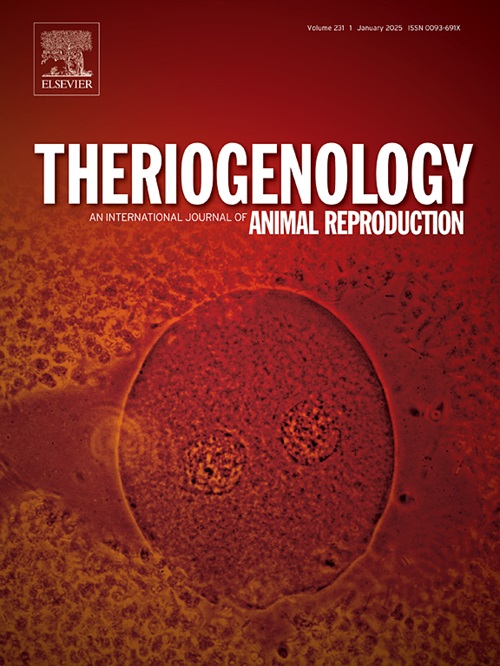miR-7通过JAK/STAT3信号通路靶向KLF4,促进鸡颗粒细胞的凋亡和自噬。
IF 2.4
2区 农林科学
Q3 REPRODUCTIVE BIOLOGY
引用次数: 0
摘要
导致卵泡闭锁的颗粒细胞(GC)死亡主要是通过细胞凋亡和自噬发生的。已知miRNA是自噬和细胞凋亡的关键调节因子。虽然miR-7是卵泡闭锁的关键调节因子,但它在颗粒细胞自噬和凋亡中的确切作用仍有待全面阐明。本研究通过 qPCR 分析发现,miR-7 在卵泡中高表达。随后,转染 miR-7 抑制剂和模拟物可下调或上调 miR-7 的表达,促进鸡卵泡颗粒细胞的自噬和凋亡过程。从机理上讲,通过双荧光素酶报告基因实验,我们验证了 KLF4 是 miR-7 的靶基因。相反,通过基因干预KLF4沉默和过表达,我们发现KLF4能负向调节卵泡颗粒细胞的自噬和凋亡。此外,JAK/STAT3 信号通路被证实介导了 miR-7-KLF4 轴对 GC 自噬和凋亡的调控。这些发现证明了miR-7-KLF4信号轴在决定GC自噬和凋亡中的关键作用。这项研究可为鸡的分子辅助育种提供重要的理论依据。本文章由计算机程序翻译,如有差异,请以英文原文为准。
miR-7 promotes apoptosis and autophagy of granulosa cells by targeting KLF4 via JAK/STAT3 signaling pathway in chickens
Granulosa cell (GC) death, which leads to follicular atresia, primarily occurs through apoptosis and autophagy. miRNAs are known to be key regulators of autophagy and apoptosis. Although miR-7 acting as a key regulator of follicular atresia, its precise role in granulosa cell autophagy and apoptosis remains to be fully elucidated. In this study, we found that miR-7 was highly expressed in the follicle based on qPCR analysis. Subsequently, transfection of miR-7 inhibitors and mimics downregulated or upregulated the expression of miR-7 and promoted autophagic and apoptotic processes in chicken follicle granulosa cells. Mechanistically, through dual-luciferase reporter gene assays, we validated that KLF4 is a target gene of miR-7. Contrarily, KLF4 was found to negatively regulate autophagy and apoptosis in follicular granulosa cells as evidenced by genetic intervention of KLF4 silencing and overexpression. Furthermore, JAK/STAT3 signaling pathway was confirmed to mediate the regulation of miR-7-KLF4 axis on GC autophagy and apoptosis. These findings offer evidences of the crucial involvement of the miR-7-KLF4 signaling axis in determining autophagy and apoptosis of GCs. This study could offer an important theoretical basis for the use of molecular-assisted breeding in chickens.
求助全文
通过发布文献求助,成功后即可免费获取论文全文。
去求助
来源期刊

Theriogenology
农林科学-生殖生物学
CiteScore
5.50
自引率
14.30%
发文量
387
审稿时长
72 days
期刊介绍:
Theriogenology provides an international forum for researchers, clinicians, and industry professionals in animal reproductive biology. This acclaimed journal publishes articles on a wide range of topics in reproductive and developmental biology, of domestic mammal, avian, and aquatic species as well as wild species which are the object of veterinary care in research or conservation programs.
 求助内容:
求助内容: 应助结果提醒方式:
应助结果提醒方式:


